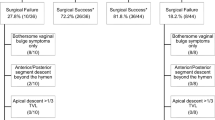Abstract
This study compares the outcomes of laparoscopic uterosacral ligament uterine suspension (LUSUS) to those of vaginal vault suspension with total vaginal hysterectomy (TVH) for the treatment of symptomatic uterovaginal prolapse. We compared the outcomes of 25 LUSUS to those of 25 TVH with vaginal vault suspension among age-matched controls. No significant complications occurred in either group. EBL and hospitalization duration were significantly less in LUSUS patients (72 cc vs. 227 cc, P < .0001 and 1.05 vs. 1.65 days, P = .002). Vault support, as measured by postoperative pelvic organ prolapse quantitation system point D in the LUSUS group and point C in the TVH group, was better for the LUSUS group (D = −9 vs. C = −7.6, P = .002). No LUSUS group patient underwent reoperation for recurrent apical prolapse as compared to three TVH patients. LUSUS is an effective treatment for appropriately selected women with uterovaginal prolapse who desire uterine preservation
Similar content being viewed by others
References
Wilcox LS, Koonin LM, Pokras R, Strauss LT, Xia Z, Peterson HB (1994) Hysterectomy in the United States, 1988–1990. Obstet Gynecol 83:549–555
Marana HR, Andrade JM, Marana RR, Matheus-de Sala M, Philbert PM, Rodrigues R (1999) Vaginal hysterectomy for correcting genital prolapse. J Reprod Med 44:529–534
Nesbitt REL (1989) Uterine preservation in the surgical management of genuine stress urinary incontinence associated with uterovaginal prolapse. Surg Gyenocol Obstet 168:143–147
Kjerluff KH, Langenberg PW, Greenaway L, Uman J, Harvey LA (2002) Urinary incontinence and hysterectomy in a large prospective cohort study in American women. J Urol 167:2088–2092
Petros PE (2000) Influence of hysterectomy on pelvic-floor dysfunction. Lancet 356:1275
Masters WH, Johnson V (1966) Human sexual response. Little, Brown, Boston
Thakar R, Ayers S, Clarkson P, Stanton S, Manyonda I (2002) Outcomes after total versus subtotal abdominal hysterectomy. N Engl J Med 347:1318–1325
Donald A (1921) A short history of the operation of colporrhaphy, with remarks on the technique. J Obstet Gynecol Br Emp 28:256–259
Bump RC, Mattiasson A, Bo K, Brubaker LP, Delancey JO, Karsov P, et al. (1996) The standardization of terminology of female pelvic organ prolapse and pelvic floor dysfunction. Am J Obstet Gynecol 175:10–17
Bonney V (1934) The principles that should underlie all operations for prolapse. J Obstet Gynaecol of Br. Empire 41:669–683
Maher CF, Carey MP, Murray CJ (2001) Laparoscopic suture hysteropexy for uterine prolapse. Obstet Gynecol 97:1010–1014
Margossian H, Walters MD, Falcone T (1999) Laparoscopic management of pelvic organ prolapse. Eur J Obstet Gynecol Rep Biol 85:57–62
Author information
Authors and Affiliations
Corresponding author
Rights and permissions
About this article
Cite this article
Diwan, A., Rardin, C.R., Strohsnitter, W.C. et al. Laparoscopic uterosacral ligament uterine suspension compared with vaginal hysterectomy with vaginal vault suspension for uterovaginal prolapse. Int Urogynecol J 17, 79–83 (2006). https://doi.org/10.1007/s00192-005-1346-x
Received:
Accepted:
Published:
Issue Date:
DOI: https://doi.org/10.1007/s00192-005-1346-x



